When it comes to maintaining a terrarium, one of the most important things to consider is how often to water it. Overwatering or underwatering your terrarium can both lead to serious consequences for the plants and animals living inside. So how can you determine the right watering schedule for your terrarium?
The frequency and amount of water your terrarium needs will depend on a variety of factors, including the size of your container, the type of plants and animals you have, and the conditions in your home. In general, it’s best to start with a light watering and gradually increase the amount as needed, while keeping a close eye on the moisture level in the soil and any signs of dehydration or waterlogging. In the following sections, I’ll provide more specific guidelines for watering different types of terrariums and offer some tips for assessing your terrarium’s watering needs.
Determining the Watering Needs of Your Terrarium
The frequency with which you need to water your terrarium largely depends on the type of plants and the environment in which they are growing. Here are some factors to consider when determining the watering needs of your terrarium:
Plant Type and Size
The type and size of plants you have in your terrarium will dictate how much water they need. Succulents, for instance, generally require less water than tropical plants. Additionally, smaller plants will need less water than larger ones, which can retain moisture for longer periods.
Humidity and Temperature
The humidity and temperature of your terrarium also play important roles in how often you should water your plants. If you live in a dry climate or keep your terrarium in an environment with low humidity, you may need to water more frequently. Areas with high humidity or moisture may require less watering.
Growing Conditions
Different growing conditions can have an impact on the watering needs of your terrarium. For example, if your terrarium has a sealed lid, it will retain moisture more effectively and may not need to be watered as much. Alternatively, an open terrarium may dry out more quickly and require more frequent watering to keep the soil moist.
Soil Moisture
Checking the moisture level of your terrarium soil is crucial to ensuring that your plants are getting the correct amount of water. Stick your finger about an inch into the soil to check how moist it is. If the soil feels dry, it’s time for watering; if it still feels damp, hold off for another day or two.
Remember that it’s always better to under-water than over-water your terrarium. Over-watering can lead to root rot and other problems, whereas a slightly dry terrarium can usually recover quickly with a little bit of moisture.
By taking into account these factors and regularly monitoring your plant’s health, you’ll be able to determine exactly how often you need to water your terrarium.
Factors to Consider when Deciding How Often to Water Your Terrarium
Light Conditions
The amount of light your terrarium receives affects how often you should water it. If your terrarium is located in a spot with bright, direct sunlight, you may need to water it more often, as the heat from the sun can cause the water in the soil to evaporate faster. Similarly, if your terrarium is in a dimly lit area, it likely won’t need to be watered as frequently, as the soil will retain moisture for longer.
Plant Type
Different types of plants have different watering needs, so it’s important to consider the species of plant in your terrarium when determining how often to water it. For example, succulents, which store water in their leaves, only need to be watered once every two weeks or so. On the other hand, ferns and other moisture-loving plants may need to be watered more frequently.
Soil Moisture
Checking the moisture level of your soil is a crucial factor in determining how often to water your terrarium. One way to do this is to use a moisture meter, which you can purchase at your local gardening store. Alternatively, you can simply stick your finger into the soil up to the second knuckle. If the soil feels moist, you can hold off on watering for a few more days. If it feels dry, it may be time to give your terrarium a good drink.
Terrarium Size
The size of your terrarium can play a role in how often you need to water it. A larger terrarium may retain moisture for longer and therefore require less frequent watering. Conversely, a smaller terrarium may dry out more quickly and need to be watered more often.
Humidity
The humidity level of your home or office can also impact your terrarium’s water needs. In drier environments, the water in your terrarium may evaporate more quickly, requiring more frequent watering. If your space is naturally humid, you may be able to water your terrarium less often.
In summary, there are several factors to consider when deciding how often to water your terrarium, including light conditions, plant type, soil moisture, terrarium size, and humidity. By taking these factors into account and regularly checking the moisture level of your soil, you can ensure that your terrarium stays healthy and hydrated.
Signs of Overwatering and Underwatering in Terrariums
As an expert terrarium enthusiast, I know that watering is one of the most crucial aspects of maintaining a healthy terrarium. Overwatering or underwatering your terrarium can lead to problems that can harm your plants. In this section, I’ll discuss the signs of overwatering and underwatering to help you maintain a healthy terrarium.
Signs of Overwatering
Overwatering is a common mistake among new terrarium owners. Here are the signs that your terrarium is being overwatered:
- The soil is constantly wet or soggy.
- The leaves of your plants turn yellow or brown and become soft or mushy.
- There is mold growing in the soil or on the leaves.
- The terrarium smells bad, indicating that there is standing water or rotting plant matter.
If you notice any of these signs, it’s time to cut back on watering. Overwatering can lead to root rot, which can kill your plants.
Signs of Underwatering
Underwatering can also be harmful to your terrarium. Here’s how you can tell if your terrarium is being underwatered:
- The soil is dry.
- The leaves of your plants wilt or curl up.
- The leaves turn yellow or brown and become dry or crispy.
- The terrarium looks parched.
If you notice any of these signs, it’s time to water your terrarium. Make sure you’re not watering too frequently or too little. Finding the right balance can be tricky, and it’s important to observe your plants regularly to make sure they’re thriving.
Remember to always use the right type of water to maintain the health of your plants. Chlorine and other chemicals in tap water can be harmful to your plants. Using distilled water or rainwater is recommended.
By keeping a close eye on the signs of overwatering and underwatering, you can maintain a healthy and thriving terrarium.
Best Practices for Watering Your Terrarium
As an expert terrarium enthusiast, I’ve learned that watering your terrarium can be a bit tricky, but following a few best practices can ensure the health and longevity of your miniature ecosystem. Here are some tips to keep in mind:
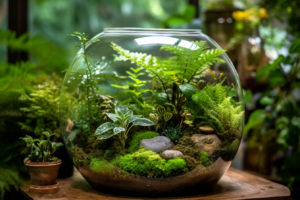
- Understand the needs of your plants: Different plants have different water requirements, so it’s important to research the type of plant you have in your terrarium and understand how much water it needs. Overwatering can lead to root rot and other issues, while underwatering can cause plants to wilt and even die.
- Use the right type of water: Tap water may contain chlorine and other chemicals that can harm your plants, so it’s best to use distilled, rain, or filtered water. Also, avoid using cold water, as it can shock the roots of your plants.
- Water sparingly: A terrarium is a closed environment, so the moisture from the soil and plants will evaporate and condense, creating a natural cycle of watering and hydration. In most cases, you only need to water your terrarium every two to four weeks. Use a spray bottle or watering can with a long spout to carefully pour water directly onto the soil, avoiding the leaves and stem of your plants.
- Monitor for signs of overwatering or underwatering: Look for wilting or yellowing leaves, brown or black roots, or mold and fungus growth, which can all be signs of overwatering. On the other hand, if the soil is dry and cracked, or your plants are turning brown and brittle, they may need more water.
Following these best practices for watering your terrarium can help you establish a healthy and thriving ecosystem that will provide beauty and enjoyment for years to come. Remember to always observe your plants closely and adjust your watering schedule as needed.
The Importance of Proper Drainage in Terrariums
When it comes to maintaining a healthy and thriving terrarium, proper drainage is key. Without adequate drainage, excess water can collect at the bottom of the container, leading to a host of issues including root rot, mold growth, and even the death of your plants.
So, what exactly does proper drainage entail? Essentially, it means ensuring that excess water is able to drain away from the soil and plant roots, allowing for air circulation and preventing waterlogged conditions.
Here are some important factors to consider when it comes to drainage in your terrarium:
- Choosing the Right Container: Selecting the appropriate container for your terrarium is crucial to ensuring proper drainage. Terrariums typically require a container with a drainage hole or a layer of drainage material (such as gravel or perlite) at the bottom to prevent water from accumulating. Without proper drainage, your plant’s roots may become suffocated and eventually die.
- Using the Right Soil: Choosing the appropriate soil mix for your terrarium is also important for drainage. Soil mixes that are too heavy or dense can retain water and prevent proper drainage. Instead, opt for a lightweight and well-draining soil mix, such as one that contains a mixture of perlite, sand, and sphagnum moss.
- Watering Appropriately: Proper watering techniques are essential for maintaining proper drainage in your terrarium. Overwatering can lead to waterlogged conditions, while underwatering can cause the soil to dry out and become compacted. Aim to water your terrarium only when the top inch of soil feels dry to the touch, and be sure to pour water directly onto the soil and not onto the leaves or stems of the plants.
By implementing these best practices for drainage in your terrarium, you can help ensure the health and longevity of your plants. Remember, a little bit of attention to detail goes a long way when it comes to providing the proper environment for your terrarium to thrive.
Choosing the Right Watering Tools for Your Terrarium
When it comes to watering your terrarium, it’s important to select the right tools to ensure your plants receive the necessary amount of water without overdoing it. Here are some essential tools to consider:
Spray Bottle
A spray bottle is a must-have tool for watering a terrarium. It allows you to provide a fine mist of water to your plants without drowning them. Most plants in a terrarium prefer a humid environment, and a spray bottle can help provide that moisture while keeping the soil surface relatively dry.
Watering Can
If you have larger terrariums, a watering can allow you to water more effectively without the need to use a spray bottle. It’s especially important to use a watering can if you have plants with deep roots that need more water.
Watering Wand
A watering wand is a useful tool for reaching deep into the terrarium and watering plants that are hard to get to. It typically comes with a long neck that enables you to reach the base of the plants and water them without disturbing the soil too much.
Dropper
Using a dropper is necessary if you have a smaller terrarium or plants that are particularly sensitive to over-watering. It provides you with the precision you need to water individual plants without drowning them in excess water.
Watering Glass
For small and delicate terrariums, a watering glass can be an excellent tool to water the plants in an attractive and precise way. It’s especially useful for watering small plants in hard-to-reach areas and allows you to avoid the risk of spilling water over other plants.
In conclusion, choosing the right watering tools for your terrarium can be the difference between a healthy and vibrant ecosystem and a stagnant and dying one. By selecting the best tools for your needs, you’ll be able to water your plants effectively without overdoing it and keep your terrarium thriving for years to come.
How to Water Different Types of Terrariums
When it comes to watering your terrarium, there is no one-size-fits-all answer. Different types of terrariums, whether it’s an open-air terrarium, closed terrarium, or a succulent terrarium, require different amounts of water and frequency. Here are some tips on how to water different types of terrariums:
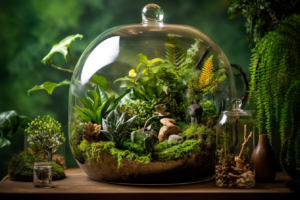
Open-Air Terrariums
Open-air terrariums are designed to mimic the natural outdoor environment, and as such, they require more frequent watering. To water an open-air terrarium, simply use a watering can or spray bottle to lightly mist the soil and plants. Ensure that the soil is moist but not waterlogged. A good rule of thumb is to water every two to four days, depending on the temperature and humidity.
Closed Terrariums
Closed terrariums are self-contained and require very little watering. The moisture in the container recycles itself, so excess water can cause issues. To water a closed terrarium, check to see if the soil is dry to the touch. If the soil is dry, use a watering can or spray bottle to add a small amount of water. A good rule of thumb is to water once every three to four weeks.
Succulent Terrariums
Succulent terrariums are drought-resistant plants that require minimal watering. It’s essential not to overwater them as it can cause root rot. To water a succulent terrarium, gently mist the soil every two weeks, or when the soil is dry to the touch. Avoid spraying the succulent leaves as it can lead to disease and rot.
When watering your terrarium, it’s essential to avoid getting water on the leaves and foliage as it can cause mold and rot. Always use room temperature water, as cold or hot water can shock the plants and affect their growth.
Understanding the specific needs of different types of terrariums will ensure that your plants thrive and stay healthy. Take the time to assess each terrarium’s specific needs and adjust your watering accordingly.
How Often to Water Closed Terrarium?
Closed terrariums create a self-sustaining environment that requires minimal maintenance, including watering. In a closed terrarium, the water cycle is maintained as the moisture evaporates from the soil and plants, condenses on the walls, and returns back to the soil.
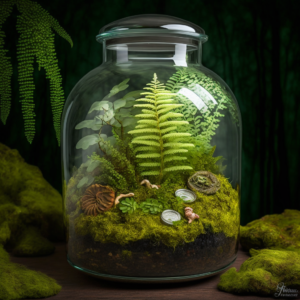
To maintain the proper balance in a closed terrarium, you should only water it when necessary. Typically, this means watering every few months, or even less frequently. Keep an eye on the moisture levels inside the terrarium. If you notice the environment is too dry, or the plants start to show signs of stress, add a small amount of water. If the environment appears too wet, or there’s excess condensation on the walls, you may need to open the terrarium for a few hours to let some moisture escape.
Always keep in mind that different plants have different water requirements, and the size of the terrarium and the type of soil used can also affect how often you should water. Monitor your closed terrarium carefully and adjust your watering schedule as needed.
How Often to Water Moss Terrarium?
Moss terrariums have different watering requirements compared to closed terrariums with a variety of plants. Mosses prefer a consistently moist environment, but not overly wet.
To maintain proper moisture levels in a moss terrarium, follow these guidelines:
- Check the moisture level: Monitor the terrarium’s moisture every few days by touching the surface of the moss or the soil underneath. It should feel damp but not soaking wet. Moss can be sensitive to fluctuations in moisture, so it’s important to maintain a consistent level of dampness.
- Watering frequency: Depending on the size of your terrarium, the type of moss, and the humidity in the room, you may need to water your moss terrarium once a week or every two weeks. If the environment is dry, you might need to water it more frequently.
- Watering method: When watering your moss terrarium, use a spray bottle to mist the moss gently with water. This ensures an even distribution of moisture across the surface. Be cautious not to overwater, as standing water can lead to mold growth and rot.
- Ventilation: If your moss terrarium has a lid or is enclosed, make sure to open it occasionally to allow for air circulation. This can help prevent mold growth and keep the environment healthy for your moss.
Remember that different moss species may have varying water requirements, so it’s important to research the specific needs of the moss you have in your terrarium. Monitor your moss terrarium closely and adjust your watering schedule as needed to maintain a healthy environment.
How Often to Water Open Terrarium?
Open terrariums, unlike closed terrariums, do not create a self-contained moisture cycle, so they require more frequent watering. The exact frequency depends on the types of plants in the terrarium, their water requirements, the size of the terrarium, the type of soil used, and the humidity in the room.
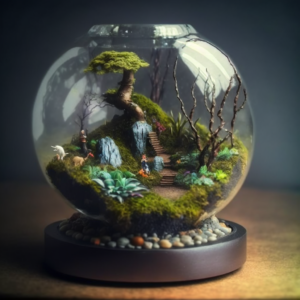
As a general guideline, consider the following steps for watering an open terrarium:
Monitor the soil moisture: Check the moisture level of the soil in your open terrarium every few days by touching it with your finger. It should feel slightly damp, but not overly wet or completely dry.
Watering frequency: Most open terrariums need watering every 5-10 days, depending on the plants and environmental conditions. Succulents and cacti in an open terrarium usually require less frequent watering, around every 2-4 weeks. Be sure to research the specific needs of the plants in your terrarium to ensure they receive the proper care.
Watering method: When watering your open terrarium, use a watering can with a narrow spout or a spray bottle to apply water directly to the soil near the base of the plants. Be careful not to overwater, as this can lead to root rot and other issues. Water the plants slowly, allowing the water to be absorbed by the soil before adding more.
Drainage: Ensure your open terrarium has proper drainage, such as a layer of pebbles or charcoal at the bottom, to prevent water from accumulating and causing problems for your plants.
Keep in mind that environmental factors, such as humidity, temperature, and light exposure, can affect the watering needs of your open terrarium. Monitor your terrarium closely and adjust your watering schedule accordingly to maintain a healthy environment for your plants.
How Often to Water Succulent Terrarium?
Succulent terrariums generally require less frequent watering compared to other types of terrariums, as succulents are adapted to survive in arid environments and can store water in their leaves, stems, or roots. However, the specific watering frequency depends on the types of succulents, the size of the terrarium, the type of soil used, and the environmental conditions.
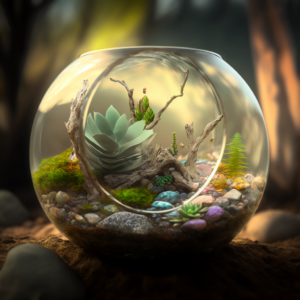
To maintain proper moisture levels in a succulent terrarium, consider the following guidelines:
- Monitor the soil moisture: Check the moisture level of the soil in your succulent terrarium every week by touching it with your finger. The soil should be allowed to dry out completely between waterings, as succulents are prone to root rot if they sit in wet soil for too long.
- Watering frequency: Most succulent terrariums require watering every 2-4 weeks, depending on the specific plants and environmental conditions. During the winter months, when succulents enter their dormant period, you may need to water even less frequently.
- Watering method: When watering your succulent terrarium, use a watering can with a narrow spout or a squeeze bottle to apply water directly to the soil near the base of the plants. Be careful not to overwater, as succulents are sensitive to excess moisture. Water the plants slowly, allowing the water to be absorbed by the soil before adding more.
- Drainage: Ensure your succulent terrarium has proper drainage, such as a layer of pebbles or charcoal at the bottom, to prevent water from accumulating and causing problems for your plants.
Keep in mind that environmental factors, such as humidity, temperature, and light exposure, can affect the watering needs of your succulent terrarium. Monitor your terrarium closely and adjust your watering schedule accordingly to maintain a healthy environment for your succulents.
Alternative Watering Methods for Terrariums
While traditional watering methods involving pouring water into the top of the terrarium can be effective, there are alternative methods that can better suit certain types of terrariums and plants. Here are a few options to consider:

Bottom Watering
Bottom watering is a method where the pots or containers are immersed in water, allowing the water to be absorbed from the bottom up. This method is great for plants that prefer their roots to be consistently moist, such as ferns and orchids. To do this, place the pot or container in a tray filled with water, making sure that the water level doesn’t rise above the pot’s soil level. Allow the plant to absorb the water for about an hour or until the soil is moist, then remove the pot from the tray.
Mist Spray
Mist spraying is a gentle way to water plants in a terrarium. This method is ideal for plants that require high humidity and don’t mind being moist but not too wet. To mist spray a plant, fill a spray bottle with clean water and spray the plant’s leaves gently. Do not spray the water directly on the soil.
Capillary Mats
Capillary mats allow plants to absorb water through their roots by simply placing the mat between the pot and tray of water. The mat acts as a wick, distributing the water evenly to the plant’s roots. This method is good for terrariums with a lot of plants or for people who go on vacation but don’t want their plants to dry out.
Overall, there are many ways to water your terrarium plants, and it’s essential to find the best method for your plants’ needs. Remember to always check the soil moisture level before watering and adjust watering frequency according to the specific needs of your terrarium.
Common Watering Mistakes to Avoid in Terrarium Care
Proper watering is crucial for the health and well-being of your terrarium. However, many beginners make a few common mistakes that can harm their plants and cause other issues. In this section, I’ll cover some of the most common watering mistakes to avoid in terrarium care.
Overwatering
Overwatering is a common watering mistake that can lead to root rot and other diseases. It’s crucial to avoid this mistake by ensuring you don’t water your terrarium too often. The frequency of watering will depend on the type of plants you have in your terrarium, but a good rule of thumb is to wait until the top inch of soil is dry before watering.
Underwatering
On the other hand, underwatering can also harm your plants. It’s essential to monitor your terrarium to ensure the soil doesn’t completely dry out. If the soil becomes too dry, it can cause the roots to die and the leaves to turn brown and crispy.
Watering at the wrong time of day
The timing of watering is also essential for the overall health of your terrarium. Watering your plant during the hottest part of the day can cause water to evaporate too quickly, and the plant may not absorb enough moisture. It’s best to water your plant in the early morning or late afternoon when the temperature is cooler.
Using the wrong type of water
Tap water often contains chemicals such as chlorine or fluoride, which can harm your plants. It’s best to use filtered water or rainwater to water your terrarium. If you have to use tap water, let it sit for 24 hours before using it to allow the chlorine to dissipate.
Watering the leaves
When watering your terrarium, avoid getting water on the leaves of your plants. Water droplets can act as a magnifying glass and cause the leaves to burn in direct sunlight. Instead, water the soil around the base of the plant.
Overfilling the water reservoir
If your terrarium has a water reservoir, be careful not to overfill it. Overfilling can cause the soil to become too wet, and it can lead to root rot and other issues. It’s best to only fill the reservoir about halfway and monitor the soil to determine if it needs more water.
Conclusion
Avoiding these common watering mistakes can help ensure the health and longevity of your terrarium. By properly watering your plants, you can enjoy a beautiful and thriving terrarium for years to come.
After all the effort you have put into creating your terrarium, proper watering is essential to ensure its longevity. Consistency is key when it comes to watering, but how often you water your terrarium depends on a number of factors, such as the type of plants, the size of your container, and the environment.
Here are a few key takeaways to remember when watering your terrarium:
- Monitor the soil moisture level regularly. Use a moisture meter or stick your finger into the soil at least 1 inch deep. If it feels dry, it’s time to water.
- Always water your terrarium with distilled or filtered water to prevent harmful chemicals and minerals from building up in the soil.
- Overwatering can lead to fungal growth and root rot, while under-watering can cause the plants to wilt and eventually die. Finding the right balance may take some time, so be patient and observe how your terrarium responds to different watering schedules.
- If you have a closed terrarium, make sure to open the lid occasionally to prevent moisture buildup and mold growth. If you have an open terrarium, make sure to avoid placing it in direct sunlight, as it can increase evaporation and dry out the soil too quickly.
By following these simple guidelines, you can maintain the health and beauty of your terrarium for years to come. Happy planting!
FAQS
Can I use tap water for my terrarium?
It's best to use distilled or filtered water, as tap water may contain chemicals or minerals that can harm your plants.
How can I tell if my terrarium is overwatered?
Signs of overwatering include yellowing leaves, mold or fungus growth, and root rot.
How can I increase humidity in my terrarium without overwatering?
Misting the plants and walls of the terrarium can help increase humidity without overwatering.
Do all plants in a terrarium need the same amount of water?
No, different plant species have unique watering requirements. Be sure to research the specific needs of each plant in your terrarium.
Can I mix plants with different watering needs in the same terrarium?
It's generally best to group plants with similar watering requirements together in a terrarium to make maintenance easier and prevent overwatering or underwatering.


Thanks for sharing, this was really helpful. I’ve been struggling with overwatering my terrarium and now I know to wait until the top layer of soil is dry before watering again.